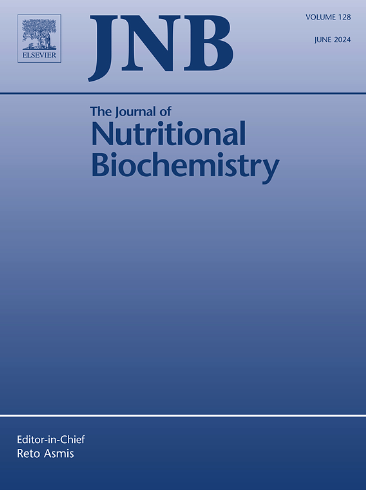木犀草素能缓解高脂饮食诱导的肥胖大鼠和棕榈酸处理的 C2C12 肌细胞的肌肉萎缩、线粒体功能障碍和 FNDC5 表达异常。
IF 4.8
2区 医学
Q1 BIOCHEMISTRY & MOLECULAR BIOLOGY
引用次数: 0
摘要
肥胖与一系列骨骼肌损伤和功能障碍有关,其特点是代谢紊乱和肌肉萎缩。木犀草素是一种酚类植物化学物质,具有广泛的药理活性。本研究旨在评估木犀草素对高脂饮食(HFD)诱导的肥胖大鼠和棕榈酸(PA)处理的 C2C12 肌管肌肉功能的保护作用,并探索其潜在机制。雄性斯普拉格-道利(SD)大鼠以对照组饮食或高脂饮食喂养,并口服 0.5% 羧甲基纤维素钠(载体)或木犀草素(分别为 25、50 和 100 mg/kg)12 周。结果表明,木犀草素可改善高纤维食物诱导的体重增加、糖耐量减低和高脂血症。木犀草素还能缓解肌肉萎缩,减少异位脂质沉积,促进骨骼肌肌纤维型转化。同时,我们观察到线粒体质量控制和呼吸能力得到明显改善,氧化应激也有所降低。机理研究表明,在木犀草素对肥胖状态下骨骼肌的保护作用中,AMPK/SIRT1/PGC-1α 信号通路起着关键作用。此外,补充叶黄素后,棕色脂肪细胞形成标志物的 mRNA 表达水平在不同脂肪贮备中均显著上调。综上所述,这些结果表明,补充木犀草素可能是预防肥胖引起的骨骼肌质量下降和生物功能障碍的一种有效策略。本文章由计算机程序翻译,如有差异,请以英文原文为准。
Luteolin alleviates muscle atrophy, mitochondrial dysfunction and abnormal FNDC5 expression in high fat diet-induced obese rats and palmitic acid-treated C2C12 myotubes
Obesity is associated with a series of skeletal muscle impairments and dysfunctions, which are characterized by metabolic disturbances and muscle atrophy. Luteolin is a phenolic phytochemical with broad pharmacological activities. The present study aimed to evaluate the protective effects of Luteolin on muscle function and explore the potential mechanisms in high-fat diet (HFD)-induced obese rats and palmitic acid (PA)-treated C2C12 myotubes. Male Sprague-Dawley (SD) rats were fed with a control diet or HFD and orally administrated 0.5% sodium carboxymethyl cellulose (vehicle) or Luteolin (25, 50, and 100 mg/kg, respectively) for 12 weeks. The results showed that Luteolin ameliorated HFD-induced body weight gain, glucose intolerance and hyperlipidemia. Luteolin also alleviated muscle atrophy, decreased ectopic lipid deposition and prompted muscle-fiber-type conversion in the skeletal muscle. Meanwhile, we observed an evident improvement in mitochondrial quality control and respiratory capacity, accompanied by reduced oxidative stress. Mechanistic studies indicated that AMPK/SIRT1/PGC-1α signaling pathway plays a key role in the protective effects of Luteolin on skeletal muscle in the obese states, which was further verified by using specific inhibitors of AMPK and SIRT1. Moreover, the mRNA expression levels of markers in brown adipocyte formation were significantly up-regulated post Luteolin supplementation in different adipose depots. Taken together, these results revealed that Luteolin supplementation might be a promising strategy to prevent obesity-induced loss of mass and biological dysfunctions of skeletal muscle.
求助全文
通过发布文献求助,成功后即可免费获取论文全文。
去求助
来源期刊

Journal of Nutritional Biochemistry
医学-生化与分子生物学
CiteScore
9.50
自引率
3.60%
发文量
237
审稿时长
68 days
期刊介绍:
Devoted to advancements in nutritional sciences, The Journal of Nutritional Biochemistry presents experimental nutrition research as it relates to: biochemistry, molecular biology, toxicology, or physiology.
Rigorous reviews by an international editorial board of distinguished scientists ensure publication of the most current and key research being conducted in nutrition at the cellular, animal and human level. In addition to its monthly features of critical reviews and research articles, The Journal of Nutritional Biochemistry also periodically publishes emerging issues, experimental methods, and other types of articles.
 求助内容:
求助内容: 应助结果提醒方式:
应助结果提醒方式:


